GetStudySolution
Getstudysolution is an online educational platform that allows students to access quality educational services and study materials at no cost.
NCERT Solutions for class 6 Maths chapter 4 – Basic Geometrical Ideas
Back Exercise
Exercise 4.1
Question 1.
Use the figure to name:
(a) Five points
(b) A line
(c) Four rays
(d) Five line segments.
Solution :
(a) O, B, C. D, E
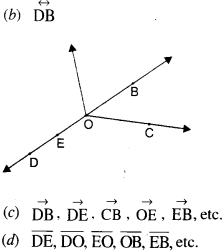
Question 2.
Name the line given in all possible (twelve) ways, choosing only two letters at a time from the four given.
Solution :
![]()

Question 3.
Use the figure to name:
(a) The line containing point E.
(b) The line passing through A.
(c) The line on which O lies
(d) Two pairs of intersecting lines.
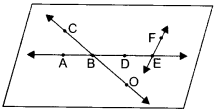
Solution :
(a)
(b)
(c)
(d)
Question 4.
How many lines can pass through
(a) one given point?
(b) two given points?
Solution :
(a) Countless lines can pass through one given point.
(b) One and only one line can pass through two given points.
Question 5.
Draw a rough figure and label suitably in each of the following cases :
(a) Point P lies on
(b)
(c) Line contains E and F but not D.
(d)
Solution :
(a)
![]()
(b)
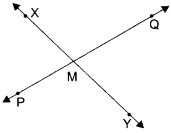
(c)
![]()
(d)
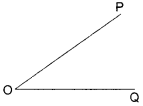
Question 6.
Consider the following figure of line
(a) Q, M, O, N, P are points on the line
(b) M, O, N are points on a line segment
(c) M and N are end points of line segment

(d) O and N are end points of line segment
(e) M is one of the end points of line segment
(f) M is point on ray
(g) Ray
(h) Ray
(i) Ray
(j) O is not an initial point of
(k) N is the initial point of
Solution :
(a) True
(b) True
(c) True
(d) False
(e) False
(f) False
(g) True
(h) False
(i) False
(j) False
(k) True.
Exercise 4.2
Question 1.
Classify the following curves as
(i) open
(ii) closed.
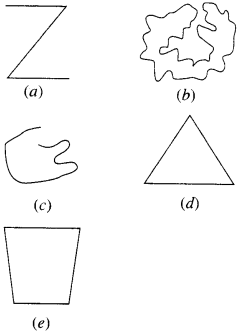
Solution :
(i) a, c
(ii) b,d,e.
Question 2.
Draw rough diagrams to illustrate the following :
(a) Open curve
(b) Closed curve.
Solution :
(a)
![]()
(b)

Question 3.
Draw any polygon and shade its interior.
Solution :
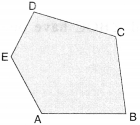
Question 4.
Consider the given figure and answer the questions:
(a) Is it a curve?
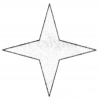
(b) Is it closed?
Solution :
(a) Yes! It is a curve
(b) Yes! It is closed.
Question 5.
Illustrate, if possible, each one of the following with a rough diagram :
(a) A closed curve that is not a polygon
(b) An open curve made up entirely of line segments.
(c) A polygon with two sides.
Solution :
(a)

(b)

(c) Not possible.
Exercise 4.3
Question 1.
Name the angles in the given figure.
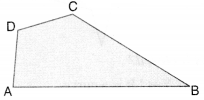
Solution :
∠A or ∠DAB; ∠B or ∠ABC; ∠C or ∠BCD; ∠Dor ∠CDA.
Question 2.
In the given diagram, name the point (s)
(a) in the interior of ∠DOE
(b) in the exterior of∠EOF
(c) on ∠EOF.
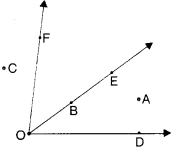
Solution :
(a) A
(b) C, A, D
(c) E, B,0, F.
Question 3.
Draw rough diagrams of two angles such that they have
(a) One point in common
(b) Two points in common
(c) Three points in common
(d) Four points in common
(e) One ray in common.
Solution :
(a)

∠AOB and ∠BOC have one point O in common.
(b) ∠AOB and ∠OBC have two points O and B in common.

(c) Not possible
(d) Not possible
(e)
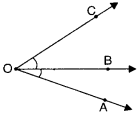
∠AOB and ∠BOC have one ray
Exercise 4.4
Question 1.
Draw a rough sketch of a triangle ABC. Mark a point P in its interior and a point Q in its exterior. Is the point A in its exterior or in its exterior?
Solution :
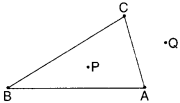
The point A is neither in the exterior nor in the interior of triangle ABC. It is on the triangle ABC.
Question 2.
(a) Identify three triangles in the figure.
(b) Write the names of seven angles,
(c) Write the names of the six line segments,
(d) Which two triangles have ∠B as common?
Solution :
(a) Three triangles
Triangle ABC,
Triangle ABD,
Triangle ADC
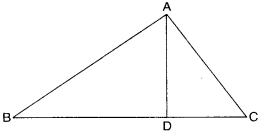
(b) Seven Angles
∠ABC. ∠ACB, ∠BAC, ∠BAD, ∠CAD, ∠ADB and ∠ADC
(c) Six line segments
(d) ΔABC. ΔABD.
Exercise 4.5
Question 1.
Draw a rough sketch of a quadrilateral PQRS. Draw its diagonals. Name them. Is the meeting point of the diagonal in the interior or exterior of the quadrilateral?
Solution :
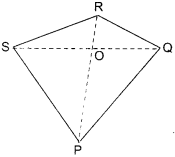
The meeting point O of the diagonals PR and QS of the quadrilateral PQRS is in the interior of the quadrilateral PQRS.
Question 2.
Draw a rough sketch of a quadrilateral KLMN. State :
(a) two pairs of opposite sides.
(b) two pairs of opposite angles.
(c) two pairs of adjacent sides.
(d) two pairs of adjacent angles.
Solution :
(a)
(b) ∠K, ∠M and ∠N, ∠L
(c)
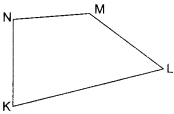
(d) ∠K, ∠L, and ∠M. ∠N or ∠K. ∠L and ∠L, ∠M etc.
Question 3.
Investigate:
Use strips and fasteners to make a triangle and a quadrilateral. Try to push inward at any one vertex of the triangle. Do the same to the quadrilateral. Is the triangle distorted? Is the quadrilateral distorted? Is the triangle rigid? Why is it that structures like electric towers make use of triangular shapes and not quadrilaterals?
Solution :
On pushing inward at any one vertex of the triangle, the triangle is not distorted, However, the quadrilateral is distorted. Hence, a triangle is a rigid figure. This is why structures like electric towers make use of triangular shapes and not quadrilaterals.
Exercise 4.6
Question 1.
From the figure identify
(a) the center of the circle
(b) three radii
(c) a diameter
(d) a chord
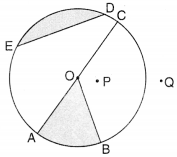
(e) two points in the interior
(f) a point in the exterior
(g) a sector
(h) a segment.
Solution :
(a) O is the centre of the circle.
(b)
(c)
(d)
(e) O and P are two points in the interior.
(f) Q is a point in the exterior.
(e) OAB (shaped portion) is a sector of the circle.
(f) Shaded portion of the circular region enclosed by line segment ED and the corresponding arc.
Question 2.
(a) Is every diameter of a circle also a chord?
(b) Is every chord of a circle also a diameter?
Solution :
(a) Yes! every diameter of a circle is also a chord.
(b) No ! every chord of a circle is not also a
Question 3.
Draw any circle and mark:
(a) it’s center
(b) a radius
(c) a diameter
(d) a sector
(e) a segment
(f) a point in its interior
(g) a point in its exterior
(h) an arc.
Solution :
(a) O is the centre.
(b)
(c)
(d) OBC is a sector.
(e) AGD is a segment.
(f) P is a point in its interior.
(g) Q is a point in its exterior.
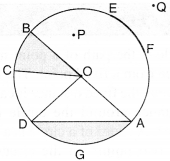
(h)
Question 4.
Say true or false:
(a) Two diameters of a circle will necessarily intersect.
(b) The center of a circle is always in its interior.
Solution :
(a) True
(b) True.